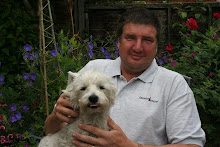 |
| Event poster for the Spring Day |
I am sneaking this post in before the normal 'due day' (Tuesday) because a) I have plenty to say already and b) I am likely to be too busy tomorrow evening what with the arrival of our Help-X volunteer. Reason 'a' has largely to do with Elizabeth playing an absolute blinder and finding me a lovely day's entertainment on Saturday. This took the form of a day of walks and talks "celebrating Spring" based in the 'village hall' buildings of nearby Kilmovee village.
 |
| Yomping through the woods |
What had caught her eye was the involvement of our main man at the National Biodiversity Database, Liam Lysaght; it turns out that his brother was setting it up. After what feels like 6 months of wet and Winter, the weather came up trumps too and the day took place in lovely warm sunshine. However, there is no point in re-inventing the wheel, so it is easiest if I just reproduce here the text of a review I offered to write for the Kilmovee website. Here it is.
 |
| Mammal Atlas (cover) |
Many, many thanks today to the team at Kilmovee for organising the excellent ‘walks and talks’ event, “A Celebration of Spring”. This was a brilliantly assembled event full of interest and healthy exercise on a gorgeous Spring day which had arrived hot on the heels of a long, wet March and April – a welcome break.
 |
| Mammal Atlas (Fox pages open) |
We started in the ‘classroom’, the village’s Thatch Roof Building attached to the Village Centre with fascinating presentations by Liam Lysaght of the National Biodiversity Database on the need for that resource, by Chris Huxley on bird migration and by Lynda Huxley on the conservation of swifts, swallows, house martins and sand martins.
 |
The ever-more-massive lamb, Bábóg. Compare this pic with
the size of her 6 weeks ago. |
Our first walk was down to a woodland around 20 minutes south of Kilmovee which was pure joy in the sunshine ‘armed’ with our assembled experts in many ecological areas – bird song, Summer migrant and other birds (we were quickly ‘shown’ willow warblers, swallows, blackcaps, mistle thrushes and chiffchaffs and even a buzzard came zooming through with a hooded crow in hot pursuit), butterflies and bees, plus botanists to point out wood sorrel, anenomes, greater stitchwort, pig-nut and the not-quite-ready bluebells.
 |
| A 4th bag of Lamlac is needed. |
There are some impressive ancient beeches in that wood too, which had us hankering for a local historian to tell us some of the past of this site.
We adjourned back to the thatched cottage for a superb lunch of soup, soda bread, sandwiches and biscuits plus, of course, tea and coffee.
 |
Not the tidiest drinker. Bábóg gets sprayed liberally on at least
one side of her face with milk. |
Refreshed, we were back into the ‘class room’ for a lovely, relaxing, post-prandial talk by local poet and writer, Terry McDonagh who is also an expert on local, famous, 1700s poet Anthony Raftery, blinded from age 10 by smallpox and the “last travelling bard” famous for his poems about Spring.
The final entertainment was a walk out to the local stone-built and excellently preserved ‘Cashel’ – a ring-wall 2m thick and 2.5m high on private land just outside the village.
 |
| Duck eggs in the incubator start 'pipping' |
Delightfully, the village is currently host to a stone-mason training course with 8 or so lads all learning the ropes just beside the thatched building. A 1000 year old stone cashel would be right up their street, so they were invited to join us as we got a look round the place and an excellent presentation by University Historian, Dr Yvonne McDermott (GMIT). Dr McDermott had done us a brilliant job but it was nice to receive some input at the Q+A from the lads coming at it from the actual builders’ point of view.
 |
| Very recently hatched - still wet. |
All together it made for a thoroughly enjoyable day and if anyone was thinking about going and then decided not to, you missed a real treat. There is talk of this possibly becoming an annual event – mark it in your diary. Thank you very, very much to the whole team at Kilmovee and to all the speakers and volunteers who made it all so good.
...and that was that.
 |
3 out and dry, now moved to the brooder box for food, water
and the warmth of an electric 'Mum' |
Friends of the Blog will know that my main involvement with Liam is through recording all my flora and fauna sightings onto the Biodiversity Database, which I have been doing now for as long as I've known it existed. They may not know that this data gets used by the team there in a whole host of ways, one of which is to produce periodic books and atlases mapping the distribution of the sightings. They had advertised that a mammal atlas was coming out in 2017 and I'd added it to my 'Dear Santa' list but we had had no luck finding a copy. The chance to actually finally MEET Liam in the flesh seemed like an equally good opportunity to obtain the book - he would surely bring me a copy down and I could pay for it there. He even autographed it for me.

It is a lovely book full of fascinating information and all that data. I get a special wee thrill when looking at the maps knowing that most of those little (10 km) squares around the north end of County Roscommon are my own data/sightings. In the back of the book is a full listing of all the 2500-odd people who contributed data and there are the names of the Woman of the House and myself.
 |
| A weighty tome. My new sheep book. |
While we are on books, I also came by a new sheep book on the recommendation of a sheep expert who I respect mightily, Tim Tyne who wrote my all time favourite sheep-for-smallholders book. When it arrived I wondered quite what I'd done. A weighty tome indeed - 690 pages hard back and weighing 1.7 kg, it looked worryingly like a medical dictionary. I spend enough time now fighting off people who think sheep are just single track animals looking for new ways to die; was I going to end up like one of those Wikipedia/Google self-diagnosers who show up at the GP claiming to have bovine tripanosomiasis? You'll be pleased to know it is a whole lot better than that and written very well to explain sheep issues to farmers who are not fully trained vets.
 |
All 9 sheep have their noses down. Well rested grass on the
front lawn is filling up their bellies. We'll have them weaned
in no time! |
Meanwhile, you will see from the pictures, that the ducklings have started to hatch. We have 3 so far from a set of 16 eggs and they are doing very well. More on them in the next post.















No comments:
Post a Comment